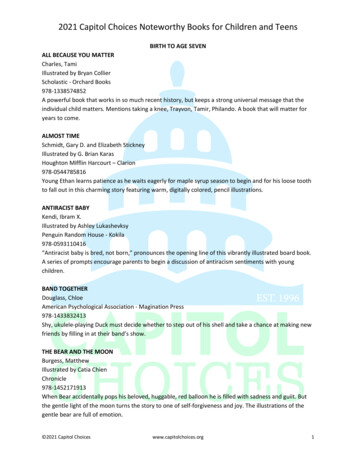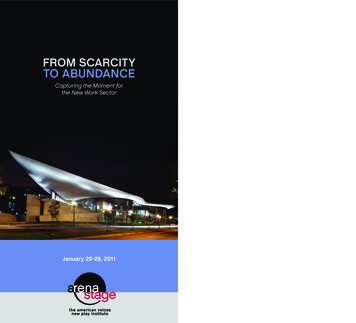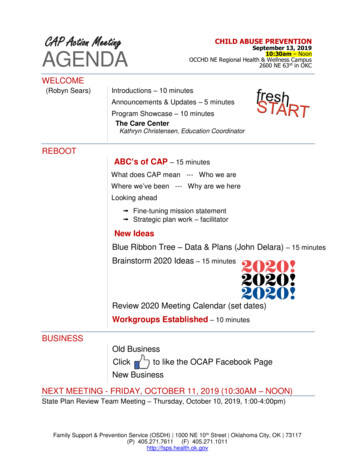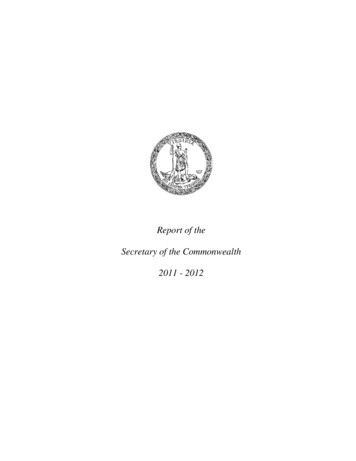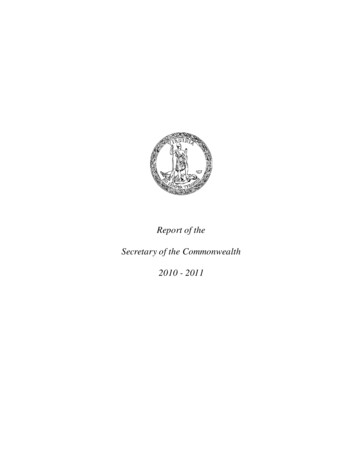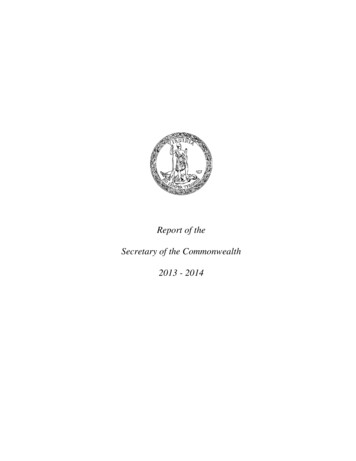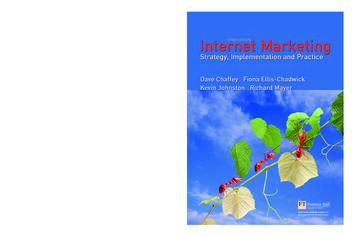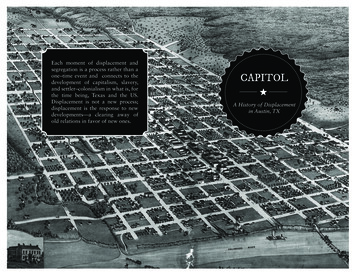
Transcription
Each moment of displacement andsegregation is a process rather than aone–time event and connects to thedevelopment of capitalism, slavery,and settler–colonialism in what is, forthe time being, Texas and the US.Displacement is not a new process;displacement is the response to newdevelopments—a clearing away ofold relations in favor of new ones.CAPITOLA History of Displacementin Austin, TX
Originally published on:THRESHOLD l/Threshold Magazine is a new project of investigation and revolutionaryanalysis in the US South. If you’re interested in discussing or gettinginvolved in the project, contact them at thresholdmag2015@gmail.com.Design & formatting for the print edition byThe Underground Publishing Wing atMONKEYWRENCH BOOKS in Austin, TXmonkeywrenchbooks.orgIn collaboration withLBJ SCHROOL OF PUBLIC AFFAIRS
CAPITOLA History of Displacementin Austin, TX
Further ReadingBarna, Joel Warren. The See-through Years: Creation and Destruction in Texas Architecture and Real Estate, 1981-1991. Houston, Tex.: Rice University Press,1992.Busch, A. “Building “A City of Upper-Middle-Class Citizens”: Labor Markets, Segregation, and Growth in Austin, Texas, 1950-1973.” Journal of Urban History,2013, 975-96.Busch, Andrew M. “Crossing Over: Sustainability, New Urbanism, and Gentrification in Austin, Texas.” Southernspaces.org. August 19, 2015. Accessed November 14, 2015.“Desegregation in Austin; Five Decades of Social Change: A Timeline.” Austin History Center. Accessed October 20, 2015. ex.cfm?action decade&dc 1950s.Gonzalez, Maya. “Notes on the New Housing Question.” Endnotes 2 (2010).Kerr, Jeffrey Stuart. Seat of Empire: The Embattled Birth of Austin, Texas. Lubbock,Texas: Texas Tech University Press, 2013.Lack, Paul D. “Slavery and Vigilantism in Austin, Texas 1840-1860.” SouthwesternHistorical Quarterly 85, no. 1 (1981): 1-20.McDonald, Jason. Racial Dynamics in Early Twentieth-century Austin, Texas. Lanham, Md.: Lexington Books, 2012.Orum, Anthony M. Power, Money & the People: The Making of Modern Austin.Austin, Tex.: Texas Monthly Press, 1987.Swearingen, William Scott. Environmental City People, Place, Politics, and theMeaning of Modern Austin. Austin, Texas: University of Texas Press, 2010.Tang, Eric, and Chunhui Ren. “Outlier: The Case of Austin’s Declining African –American Population.” University of Texas Website. May 8, 2014. http://www.utexas.edu/cola/iupra/ files/pdf/Austin AA pop policy brief FINAL.pdf.Tretter, E. “Sustainability and Neoliberal Urban Development: The Environment,Crime and the Remaking of Austin’s Downtown.” Urban Studies, 2013, 2222237.Tretter, Eliot M. “Contesting Sustainability: ‘SMART Growth’ and the Redevelopment of Austin’s Eastside.” Int J Urban Reg Res International Journal of Urbanand Regional Research, 2012, 297-310.Ward, Tane. “Finding Loston.” The End Of Austin. December 19, 2013. 17
workers, some of whose ancestors were slaves, in remote ghettos. Economicsegregation and the ordering of the city keep all workers transient. The mostrecent City Plan, titled “Imagine Austin,” calls for two high density development zones: one through the central city along Interstate 35, and anotherfar east of the “Crescent” along newly constructed toll road Highway 130.One can only imagine who will live amidst existing industrial and resourceextraction sites by 2039, the City of Austin’s bicentennial—the date ImagineAustin hopes to be completed.In the beginning of this story, the Comanches tried to destroy the nascent city. The slaves tried to burn it down. Fixes based on repression and removal have appeared to restore order but replace old crises with new ones.Where will these new struggles emerge? Will we recognize Engels’ warningthat the relocation of working class districts is constant and will not enduntil the capitalist mode of production is abolished? It is clear that whitesupremacy creates specific types of displacement in the service of capitalism.As long as planning and policing determine the city’s contours of relocation,we can expect nothing more from Austin.— Scott Hoft, November 2015scotthoft@gmail.comThe growth of the big modern cities gives the land in certain areas,particularly in those which are centrally situated, an artificialand often colossally increasing value; the buildings erected onthese areas depress this value, instead of increasing it, becausethey no longer correspond to the changed circumstances. Theyare pulled down and replaced by others. This takes place aboveall with workers’ houses which are situated centrally and whoserents, even with the greatest overcrowding, can never, or onlyvery slowly, increase above a certain maximum. They are pulleddown and in their stead shops, warehouses and public buildingsare erected The result is that the workers are forced out of thecentre of the towns towards the outskirts; that workers’ dwellings,and small dwellings in general, become rare and expensive andoften altogether unobtainable, for under these circumstancesthe building industry, which is offered a much better field forspeculation by more expensive houses, builds workers’ dwellingsonly by way of exception.– Friedrich Engels, The Housing Question, 1872Austin is booming. According to the city’s demographers,hundreds of people move here every day. Cranes flock on the skylines andsuburbs extend in every direction. Through ups and downs the city has doubled in population every twenty years. It appears on dozens of top ten lists,including that for the most economically segregated city. This economicsegregation closely maps onto segregation by race, the legacy of centuries.165
Public discussion of Austin’s segregated nature has peaked in recentyears. The current debate usually starts with the moment of segregation,the Plan of 1928, and leaps to present–day gentrification. The question nowis how to preserve as much of this cultural territory as possible. Missingis the before and after of 1928: how the city came to be in central Texas, by whom, and the usage of displacement throughout Austin’s history.Each moment of displacement and segregation is a process rather than aone–time event and connects to the development of capitalism, slavery, andsettler–colonialism in what is now Texas and the US. Displacement is not anew process; displacement is the response to new developments—a clearingaway of old relations in favor of new ones.I focus on the situations of Tribal peoples who lived here during colonization, Mexican people and Black people, with an emphasis on the latter.Austin was established as a slave society and bears the marks today. Theexploitation of Black people provided the wealth with which the city wasbuilt and their continual displacement after emancipation shows the depthof the problem posed by free Black people. The city has long struggled tofind a place for Black people in its economy, but has managed to keep themout of the way in peripheral ghettos. The Black population in Austin hasdecreased from around 30% shortly after Austin’s establishment to around7% in 2010 and is on the path to shrink even more.In this brief paper, I hope to demonstrate Austin’s continual remakingand evolving tools in the service of capital and white supremacy. This is inthe interest of showing the hand of the city instead of the “invisible hand”of the market. The city’s planning and policing clear the way and set theterms for the movement of capital while declaring, dividing and redistributing property to assert a certain social “peace.”An Act of WarAustin had not been established when the Republic of Texas was born.Texas was the colonial project of Spain and then Mexico, who had createdseveral lasting settlements along with religious and trade networks, mainlyto the south. Unable to occupy the rest of the state and left open to Indianattacks from the north, the Spanish and Mexican governments conscriptedempresarios from the US to draw Anglo settlement as a buffer. While initially happy to be Mexican subjects, the settlers revolted and for a short timeformed their own nation: Texas.At that time, the government met in a wooden building in Houston,and the community sitting where Austin sits today was an unincorporatedvillage named Waterloo, founded by Edward Burleson, land speculator and“Ole Indian Fighter.” Future Texas President Mirabeau B. Lamar fought6to “Restore Rundberg,” a largely working class POC community in NorthAustin. Restore Rundberg is the latest in a string of police-driven programsto clean up the neighborhood at the northern point of the Crescent. Witha grant from the Department of Justice, the program brings together theAustin Police Department, the UT School of Social Work and neighborhoodgroups to create sustainable “crime solutions” for the area.The DOJ grant comes from the Obama administration’s Neighborhood Revitalization Initiative to address “concentrated poverty” in citiesacross the US. This harkens back to “slum clearance,” targeting areas bydeclaring them slums (though in more fashionable language). It identifiescrime as an impediment to “redevelopment and economic growth.” The cityno longer has to clear entire neighborhoods, relying instead on the full arrayof public-private partnerships to transform social relationships that favorcapital.The Austin QuestionThis is a striking example of how the bourgeoisie solves the housingquestion in practice. The breeding places of disease, the infamousholes and cellars in which the capitalist mode of productionconfines our workers night after night, are not abolished; theyare merely shifted elsewhere! The same economic necessity whichproduced them in the first place, produces them in the next placealso. As long as the capitalist mode of production continues toexist, it is folly to hope for an isolated solution of the housingquestion or of any other social question affecting the fate of theworkers. The solution lies in the abolition of the capitalist mode ofproduction and the appropriation of all the means of life and laborby the working class itself.– Friedrich Engels, The Housing Question, 1872The city is still growing at a rapid clip and is polarizing at the samerate. The working poor population is expanding, at once an effect of proliferating low wage service jobs and a rapidly climbing area – wide cost ofliving, the highest in the state. Renting an average two bedroom apartmentin the city requires a 111-hour work week at a minimum wage job. Wherewill these workers live?Organizers must face these questions as the city grows. People at thehistoric sites of struggle have fought long and hard, but new struggles emergeevery day. The city has developed an impressive array of tools to keep its15
from anonymous tip line callers. They are known to be a tool for developerswho register complaints against whole city blocks to levy additional fines onresidents of dilapidated housing.Though some remain, many of the residents of the historically segregated zones in East Austin have relocated to the suburbs of Pfulgerville,Round Rock, Manor, and Elgin. This year a study showed the rapid declinein Austin’s Black population, a statistical anomaly for a city of its size. Whilethe city’s population grew by 20.4, percent the black population shrank by5.4 percent.The police are responding to the changing face of Central East Austin.In 2012, APD implemented a plan to shut down “The Corner” at the intersection of 12th and Chicon. For 40 years “The Corner” was known as anopen air drug market and hang out zone. In a single year APD shut it downwith a Drug Market Intervention program, using mass arrests to apprehendeveryone in the sweep, then connecting low level dealers with social serviceprograms and high level dealers with prison time.“Go East, My Friends”While Austin’s urban core has drawn successful investment, suburbangrowth has not ebbed. Over the course of the late ‘90s, ‘00s and ‘10s the suburbs have continued to expand. They have also gotten poorer. Austin madethe lists again, boasting the second fastest growing rate of suburban poverty; this population grew by more than 140 percent between the 2000 and2010 US Census Reports. The need for free and reduced cost school lunchprograms and suburban food banks has increased anywhere from fifteen totwenty percent. The dispersal of poor people from the city has pushed socialservice centers to follow their clients into the suburbs. Two providers in Austin are relocating or opening new offices in northeast Austin. In 2013, TravisCounty increased its spending on social services by several million dollars,the first increase in a decade.Police also recognize this reorganization. Even ten years ago, the police would often escort homeless people to the central East Side. Today thepreferred drop points are far north or south, away from the city’s core. Thepolice chief is a strong advocate for moving homeless and social servicesout of the central city altogether, allying with downtown business interestswho would like to see the city’s homeless shelter moved. A new monikerdescribes the part of East Austin downtown has not absorbed: “the EasternCrescent.” The “Crescent” overlaps the former dividing line of Interstate 35at two points, north and south, but is primarily concentrated around thehighway that skirts what was the eastern edge of the city.Within the Crescent, police and community activists are teaming up14other Texas politicians to place the capitol in Waterloo. Building the capitolin central Texas would project Anglo power westward into territory thathad never been successfully colonized by the Spanish or the Mexican governments.Lamar envisioned not only the capitol, but an accompanying barrier ofwestern forts to protect the interior of Texas from Comanche Indian raids.These raids were ongoing in frontier communities and would continue fordecades. According to some historians, the Comanches saw the establishment of Austin for the act of war it was. When Edwin Waller was commissioned in 1839 to plot the city, two of his surveyors were ambushed, scalpedand killed by raiders; an act of resistance at the moment of Austin’s birth.Despite this, the land was mapped and contents, colonizers, and slaveswere shipped in from Houston under the armed guard of the Texas Rangers to prevent further Indian attacks. Anglo laborers worked seven days aweeks with no holidays in order to get the new capitol ready for Texas’sFourth Congress. The layout included a 14-by-14 block grid with the Capitol campus situated to the north and land designated for a penitentiary atthe southwest corner.Anglo laborers and squatters hoping for first dibs on the best landslept in open camps or in tents. Word had gone out that the governmentwould give squatters good terms for their chosen land, and the opportunityto make money on its fast increasing value and much needed goods andservices drew many into town. In fact, land speculation in Austin was partof Lamar’s plan to pay for its frontier defense.Some of these goods were Black people—slaves who were hired out tothe Texas government to build Austin and work on the cotton plantationsof Central Texas.Slavery & VigilanceSlavery had been one of the tensions in the war for independence fromMexico. Settlers coming from the southern US into Stephen F. Austin’s colony had brought their slaves with them. The Mexican government had forbidden slavery shortly after its own independence from Spain was granted,making a temporary exception for Texas. When the Mexican governmenthalted the importation of slaves entirely, Anglo tempers flared and their immigration into Texas slowed considerably. To get around the ban slaveowners used many tactics, including forcing slaves to sign life contracts asindentured servants.When the Texan war for independence began, some slaves foughtfor Mexico and the promise of freedom. Some took action independentlyagainst their masters and staged insurrections around the state. As Texas7
won, so did slavery, and its legislature made quick time to establish slavecodes. They gave free Black people notice to leave the state and decreedthat masters could not free their slaves without the direct consent of theCongress.By January of 1840, 145 of Austin’s 856 residents were Black, close to17 percent. It had been three years since the Mexican ban on slavery hadbeen lifted with Texas independence. By 1860 this number had risen to 28percent.Cotton plantations ringed the capitol. These were not vast as in theDeep South but employed enough to be worked by smaller groups of Blackslaves. Austin was also a trading center for the region in the 19th centuryand well into the 20th. Bales were brought into town, then shipped to England for manufacture. Many of Austin’s elites became rich through thistrade, benefitting directly from slave labor.Like in other urban centers, slaves in Austin took liberties that violatedwhite concepts of race relations, gathering in public, drinking and living ontheir own outside of white surveillance. Many were allowed to buy theirown time from their masters and kept their own houses, in violation of law.Restrictions on contact with other races were meant to keep Black slavesdocile. Whites were especially worried about contact with Mexicans; as freepeople of color they threw into question the racial hierarchy.Sitting in the middle of cotton country, whites feared Black insurrection and flight to freedom in Mexico. Austin passed its own slave codes andmade several attempts to enforce these. Before 1850, the city relied onlyupon a City Marshall and his ad hoc deputies. In 1850, Austin created acity watch which had authority to mete out punishments without resortingto trials.Fear of Black insurrection rolled through Austin several times beforeslavery ended and extralegal Vigilance Committees were organized as a response. Made up of city officials, traders, and farmers of upper, then middle,class, these committees investigated arsons along with other insurrectionaryplots. The Vigilance Committees also addressed the “problem” of Mexicansand evicted them from town.In the Wrong Place, All of the TimeAs the Civil War ended and emancipation was declared, freedmen leftthe plantations in droves. Many settled nearby their former quarters, east,west, south and north. Some were given land by their former masters, somebought it, others squatted along creeks or in the woods.The Freedmen’s colonies were often just outside of town and providedrelative autonomy though freedmen were integrated into the local economy8and the question of where to put all the people. In the ‘70s and ‘80s capitalwas searching the globe looking for investments, and wherever it could notfund production it funded speculation. In Austin this took the form of aseries of bubbles as land prices rose steadily and fell rapidly.Can’t Stop ProgressThis combination of population growth in the region and land speculation meant large scale building and development projects all around thecity. Environmentalists tapping into a conservationist current in the city rallied to halt growth in environmentally-sensitive areas on the edges of town,mainly aquifers, creeks and farmland. This battle was fraught and full oflosing battles as activists and city officials tried to put the reins on suburbandevelopment but were stymied by the State government.In 1980, a new city plan was passed reflecting these concerns: the Austin Tomorrow Plan. The plan attempted to limit urban core growth anddraw it away from environmentally-sensitive areas. To do this, plannersused an aggressive annexation strategy to bring sensitive land under citycontrol, to encourage development of undeveloped areas in the urban core,and to redevelop poorer areas of the city. Building on this, in the late ‘90s,Mayor Kirk Watson began to promote what he called “SMART Growth”in hopes to resolve the conflict between developers and environmentalists.A new breed of developers and larger changes in the organization of citiesworldwide accompanied Watson. Finance, real estate, technology, and theservice sectors replaced production in the inner city. The City Council prioritized this growth downtown, giving subsidies and tax breaks to companieswho chose downtown over suburban areas on the aquifer.Downtown increasingly meant East Austin. Maps included in theSMART Growth plans marked a large portion as desired-development zones.Environmental Justice organizers from Eastside group PODER (People Organized in Defense of the Earth and her Resources) noticed that their pushto remove industrial facilities from the neighborhood had found strangebedfellows—developers who pushed to move the facilities further into theEastside along with their people. One former Brown Beret remarked thatSMART stood for “Send Minorities Across the River Today.”Developers began to buy land cheaply on the Eastside as the city provided more and more infrastructure for development. A new rail system, renewal of roads in business corridors, bike lanes, public-private housing, andretail developments on city-owned land have been installed since the late’90s. Many longtime residents see the additions as improvements built fornewcomers. Property taxes have been increased for longtime homeowners,and many have left. City Code Enforcement makes the rounds, taking notes13
been Black officers since the beginnings of the APD, they had only beenallowed to police Black people. Even after this ended, Black officers workedbeats on the Eastside. Several small uprisings in which East Austin residentsfought off Austin Police Officers and the changing political climate of the‘60s led the Police Department to try and address a legitimacy crisis. Theybegan a campaign to attract more Black and Latino people to the force anddesegregated its beats.Mid 20th century Austin began to assume its modern form. Suburbsexploded out of the central city as the city boomed. From 1959 to 1969, thepopulation of Travis County grew by 39 percent. In addition to the University of Texas, there was a military presence: an Air Force base in SoutheastAustin, military research facilities in north Austin, a “castle” in West Austinthat held a training school, and Camp Mabry, a camp for the Texas Volunteer Guard. This military presence is perhaps unsurprising given Austin’sfrontier beginnings and its location to project Anglo military power west.The city took advantage of its academic and military connections tobuild its high-tech industry. LBJ orchestrated a deal in which The University of Texas absorbed the military’s research facilities in north Austin. TheUniversity maintained this as a public research facility (Balcones ResearchCenter) but endorsed several private companies and a committee to lurehigh-tech investment into Austin. Soon enough, research and production facilities surrounded Austin on cheaper suburban land with housing providedby FHA loans. New roads were built, including Highway 183 which linkedresearch in Northwest Austin to production in far East Austin. Productionfacilities were built in the eastern industrial district to spur job creation,which frustrated many early environmental activists, but was promoted byBlack councilman Charles Urdy who hoped jobs would go to Black EastAustinites.Into the ‘80s tech kept coming. The concerted effort of Texas politicians and capitalists brought the Microelectronics and Computer Technology Corporation (MCC) to Austin in 1983. the University of Texas gaveMCC land; 15 million in endowed faculty chairs for thirty new facultyin computer science and electrical engineering; 1 million each year for research; 750,000 for 75 graduate students; 5 million for new equipment;and a nominal cost for leasing parts of the Balcones Research Center.The suburbs drew jobs and housing away from Central Austin; downtown hosted state workers and some commerce during the day but becamea ghost town after dark. Offices and warehouses withdrew. As cars becamemore common, a glut of student-oriented apartments were built in Southeast Austin along Riverside Drive, far from the university. Never entirelyabandoned, the emptying of the city provided room for future rounds ofinvestment.In the midst of all of this was the burgeoning struggle over development. With investment in high tech infrastructure came population growth12and subject to frequent harassment. The West Austin Freedman’s Colonyof Clarksville established a Confederate Veterans’ Home where the citydumped its garbage.The arrival of the railroad consolidated the cotton industry circa 1900.Small land owners needed cheaper labor to work industrial sized farms andwere dispossessed. This was a period of intense urban migration, and Blacksand Mexicans moved to the city in droves. Many moved to East Austinwhere there was already a dense concentration of Black people.Eventually, Austin’s growth led to encroachment on these once peripheral communities, as in the case of Charles Clark’s Clarksville. Clark wasthe former slave of Governor Elisha Pease, whose Greek revival estate stillstands today in West Austin. A bridge over Shoal Creek in the 1920’s sentdevelopment up 12th Street from the Capitol, and forest was cleared tomake room. What is now Lamar Boulevard was also built as a highway toDallas through the western end of the area. This was the beginning of theassaults on the colonies.As the white central city expanded and a segregationist movementpicked up nationwide, Austin’s elites hopped on. The 1928 city plan reflected this, not only establishing Black and Mexican districts for city servicesbut designating this area for industry as well. These districts, marked byEast Avenue in the west (now Interstate 35), came to be known as “the Eastside,” but segregation into these districts only came after decades of workby white elites.The Dallas-based planning firm Koch and Fowler, writers of the 1928plan, were restricted by a US Supreme Court ruling from advocating thedirect seizure of property of Black and Mexican people. They acknowledgethis themselves in the text of the plan. In line with the national segregationist movement, they advised a workaround: the segregation of city services.Roads, electricity, water, and schools were all withheld. These were tobe provided only in the segregated districts. Blacks and Mexicans remainingin West Austin would be denied them. The Wheatville school which servedBlack West Austin was closed. In addition to the pulls of city services, therewere programs which served to push them out. Harassment continued asbefore. Ordinances which outlawed urban rearing of animals were passedand enforced. By these measures, almost all Black people were relocated tothe Eastside by 1932.In 1937, shortly after segregation, Lyndon Johnson, then US Senatorfrom Texas, used a speech to expose Austin’s slums. This opened up an intense city-wide debate about the slums’ existence. The Chamber of Commerce had advocated against the movement of heavy industry to Austin.They reasoned, “heavy industry brought poverty and poverty promotedslums.” If there was no heavy industry in Austin, how could there be slums?9
For the Health of the CityUrban Renewal began in 1949. Title One of the Federal Housing Act(FHA) passed and encouraged slum clearance and redevelopment fundedlargely by the federal government, releasing large swaths of land to privatedevelopers to sell for a large profit. Shortly after Title One’s passage, a private consulting firm designated 10 percent of the city as slums.The FHA’s most famous provision was available credit for home ownership, ostensibly resolving a housing crisis exacerbated by the return ofveterans of World War II. Non-whites were frustrated in their attempts togain access to this credit. (A map from 1937 shows a private bank’s highrisk “redlined” areas, used to deny loans to people in several districts. Onealmost perfectly overlays the Negro District.) The FHA and the Veteran’sAdministration supported racial covenants around the country into the1960s. At the same time the FHA encouraged the seizure and clearing ofneighborhoods populated by non-white communities.A 1953 city plan recognized that business leaders would make expansive decisions regarding the postwar economic surplus in the US. The citysought to redesign its geography in a way that would remove areas “thathave become obsolete and fallen into disrepair” to attract business. Using areport by the Housing Authority of Austin and data from the 1950 census,the city made its case. This data was eventually used by the Austin UrbanRenewal Agency founded in 1959. Many homes in East Austin had no bathroom. In the districts covered by the Plan, two thirds of crime occurred thereeven though they only contained 25 percent of the city’s population. Likewise fires, delinquency, and tuberculosis were disproportionately high. Aflyer promoting Slum Clearance attempted to address this disproportionateuse of city tax dollars and the repopulation of higher income individuals asa way to equalize the city’s tax burden.Here, the designation of “slum” served as a way for the city government to segregate Austin in a “race-neutral” manner. The 1950 figures usedin every annual report in the URA’s existence justified extreme measures.City code determined houses to be substandard, and demands for repair fellon largely poor occupants, many of whom did not own their homes. Homeswere condemned, then seized by the city en masse.The slum districts were all eventually cleared and rebuilt. Notably, districts west of East Avenue were turned over to institutions. Hospitals, statebuildings, and university buildings were all built on top of former Black andMexican Neighborhoods. At the same time, in the late 50s and early 60s,Interstate 35 supplanted East Avenue, cementing the division.Alongside slum clearance and Urban Renewal came struggles overp
MONKEYWRENCH BOOKS in Austin, TX monkeywrenchbooks.org In collaboration with LBJ SCHROOL OF PUBLIC AFFAIRS. CAPITOL A History of Displacement in Austin, TX. 17 Further Reading Barna, Joel Warren. The See-through Years: Creation and Destruction in Texas Ar-chitecture and Real

